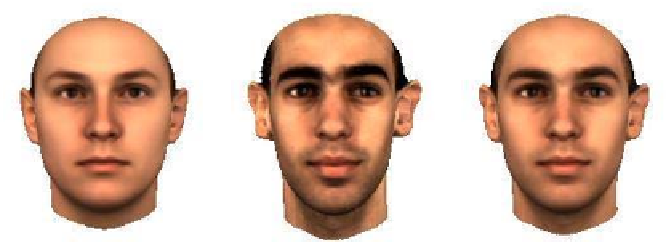Image Processing Reference
In-Depth Information
(a)
(b)
(c)
Figure 2.1:
Morphable face models
Blanz and Vetter
[
1999
]. (a) The average face. (b) Weighted of sum
of deformation modes that depicts the face of a specific person. (c) Setting the weights to half the values
used in (b) produces an intermediate face. Courtesy of T. Vetter.
a single vector and to mix physics-based approaches with statistical learning
Nastar
et al.
[
1996
].
To account for illumination variations, an Active Illumination and Appearance model was intro-
duced
Kahraman
et al.
[
2007
]. In a similar spirit of being robust to illumination changes, a light-
invariant AAM was proposed
Pizarro
et al.
[
2008
], which relies on a light-invariant transforma-
tion
Finlayson
et al.
[
2006
]. Finally, hierarchical AAM were introduced to make image fitting more
robust and efficient
Cosker
et al.
[
2004
],
Peyras
et al.
[
2007
]. To this end, the fitting process is done
in a coarse-to-fine manner, starting from the whole face and refining individual parts.
The AAM were later turned into a Morphable Model
Blanz and Vetter
[
1999
],
Romdhani and Vetter
[
2003
] designed to recover the full 3D shape of a face, which produced ex-
tremely impressive results using a single properly-lit high resolution image. It was also used to model
various expressions of a same face
Blanz
et al.
[
2003
] and combined to an AAM to further account
for appearance of the face instead of shape only
Xiao
et al.
[
2004a
]. Fig.
2.1
depicts the model and
illustrates the fact that the space of faces modeled in this way can indeed be considered as linear
since a weighted sum of such models still looks like a face. Because the shape and texture recovery
may be perturbed by large cast shadows or specularities, it was later shown that the sensitivity to
illumination could be reduced by replacing the appearance-based component of the model by infor-
mation provided by 2D point correspondences in all pairs of consecutive images of a video sequence
in which the head moves rigidly
Dimitrijevic
et al.
[
2004
], as shown in Fig.
2.2
. This is because
such correspondences tend to be affected comparatively little by illumination changes given proper
normalization.
Nonlinear methods have also proved useful for Computer Vision applications. In particular,
the GPLVM was used to learn a prior on human pose and proved able to generalize well from a
small number of training examples
Urtasun
et al.
[
2005
]. Similarly, the GPDM was also applied to
constrain the 3D estimation of humans poses in video sequences
Urtasun
et al.
[
2006
]. For non-rigid
surface reconstruction, a sparse GPLVM was employed to learn a prior over the deformations of

Search WWH ::

Custom Search